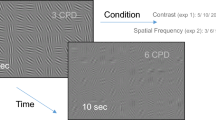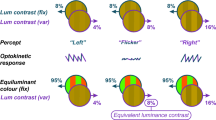Abstract
Cases in which salient visual stimuli do not register consciously are known to occur in special conditions, such as the presentation of dissimilar stimuli to the two eyes1 or when images are stabilized on the retina2. Here, we report a striking phenomenon of ‘visual disappearance’ observed with normal-sighted observers under natural conditions. When a global moving pattern is superimposed on high-contrast stationary or slowly moving stimuli, the latter disappear and reappear alternately for periods of several seconds. We show that this motion-induced blindness (MIB) phenomenon is unlikely to reflect retinal suppression, sensory masking or adaptation. The phenomenology observed includes perceptual grouping effects, object rivalry and visual field anisotropy. This is very similar to that found in other types of visual disappearance, as well as in clinical cases of attention deficits, in which partial invisibility might occur despite the primary visual areas being intact3. Disappearance might reflect a disruption of attentional processing, which shifts the system into a winner-takes-all mode, uncovering the dynamics of competition between object representations within the human visual system.
This is a preview of subscription content, access via your institution
Access options
Subscribe to this journal
Receive 51 print issues and online access
$199.00 per year
only $3.90 per issue
Buy this article
- Purchase on Springer Link
- Instant access to full article PDF
Prices may be subject to local taxes which are calculated during checkout




Similar content being viewed by others
References
Breese, B. B. On inhibition. Psychol. Monogr. 3, 1–65 (1899).
Ditchburn, R. W. & Ginsborg, B. L. Vision with a stabilized retinal image. Nature 170, 36–37 (1952).
Driver, J. & Vuilleumier, P. Perceptual awareness and its loss in unilateral neglect and extinction. Cognition 79, 39–88 (2001).
O'Regan, J., Rensink, R. & Clark, J. Change-blindness as a result of ‘mudsplashes’. Nature 398, 34 (1999).
Blake, R. A neural theory of binocular rivalry. Psychol. Rev. 96, 145–167 (1989).
Campbell, F. W., Glinsky, A. S., Howel, E. R., Riggs, L. A. & Atkinson, J. The dependence of monocular rivalry on orientation. Perception 2, 123–125 (1973).
Andrews, T. J. & Purves, D. Similarities in normal and binocularly rivalrous viewing. Proc. Natl Acad. Sci. USA 94, 9905–9908 (1997).
Bennet-Clark, H. & Evans, C. Fragmentation of patterned targets when viewed as prolonged after-images. Nature 199, 1215–1216 (1963).
Troxler, D. in Ophthalmologisches Bibliothek (eds Himly, K. & Schmidt, J. A.) 51–53 (Fromman, Jena, 1804).
Luria, A. R. Disorders of ‘simultaneous perception’ in a case of bilateral occipito-parietal brain injury. Brain 82, 437–449 (1959).
Rizzo, M. & Robin, D. A. Simultanagnosia: a defect of sustained attention yields insights on visual information processing. Neurology 40, 447–455 (1990).
Grindley, G. C. & Townsend, V. Binocular masking induced by a moving object. Q. J. Exp. Psychol. 17, 97–109 (1965).
Grindley, G. C. & Townsend, V. Further experiments on movement masking. Q. J. Exp. Psychol. 18, 319–326 (1967).
Bonneh, Y., Cooperman, A. & Sagi, D. Loss of local pattern visibility in global shape perception. Invest. Ophthalmol. Visual Sci. (Suppl.) 40, 4253 (1999).
Livingstone, M. S. & Hubel, D. H. Psychophysical evidence for separate channels for the perception of form, color, movement, and depth. J. Neurosci. 7, 3416–3468 (1987).
Evans, C. Some studies of pattern perception using a stabilized retinal image. Br. J. Psychol. 56, 121–133 (1965).
Kovac’s, I., Papathomas, T. V., Yang, M. & Feher, A. When the brain changes its mind: interocular grouping during binocular rivalry. Proc. Natl Acad. Sci. USA 93, 15508–15511 (1996).
Walker, P. The perceptual fragmentation of unstabilized images. Q. J. Exp. Psychol. 28, 35–45 (1976).
Fukuda, H. & Blake, R. Spatial interactions in binocular rivalry. J. Exp. Psychol. Hum. Percept. Perform. 18, 362–370 (1992).
Bonneh, Y. & Sagi, D. Configuration saliency revealed in short duration binocular rivalry. Vision Res. 39, 271–281 (1999).
Burbeck, C. & Kelly, D. Role of local adaptation in the fading of stabilized images. J. Opt. Soc. Am. 1, 216–220 (1984).
Logothetis, N. K. Single units and conscious vision. Phil. Trans. R. Soc. Lond. B 353, 1801–1818 (1998).
MacKay, D. M. in Visual Neuroscience (eds Pettigrew, J., Sanderson, K. & Levick, W.) 365–373 (Cambridge Univ. Press, Cambridge, New York, 1986).
Pettigrew, J. D. & Funk, A. P. Opposing effects on perceptual rivalry caused by right vs. left TMS. Soc. Neurosci. Abstr.(in the press).
Duncan, J., Humphreys, G. & Ward, R. Competitive brain activity in visual attention. Curr. Opin. Neurobiol. 7, 255–261 (1997).
Colby, C. & Goldberg, M. Space and attention in parietal cortex. Annu. Rev. Neurosci. 22, 319–349 (1999).
Acknowledgements
We thank J. D. Mollon for recently drawing our attention to the work of Grindley and Townsend13. We thank E. Freeman, B. Zenger, S. Gepshtein, H. Reed, J. Pettigrew and M. Merzenich for their helpful comments.
Author information
Authors and Affiliations
Corresponding author
Supplementary information
This demo demonstrates several properties of the Motion Induced Blindness (MIB) phenomenon. It is implemented as a set of GIF animation and can only be appreciated if the apparent motion appears smooth or almost smooth. In general, fixate in the center or lower part of the screen without moving the eyes, pay attention to the moving pattern and observe what happens to the static yellow dots. For better results, download an executable version of the demo, available for Linux x86 and Windows systems. The demo is best perceived in the dark.
Properties
-
Basic effect
-
Target luminance: Low, High
-
Target movement: Slow, Fast
-
Target dynamics: Flicker, Local rotation
-
Target size
-
The spatial extent: "Protection zones"
-
Mask properties: 3D slow, 2D, 1D, Noise, Few dots
Gestalt Effects
-
Contour smoothness: Smooth, Jagged
-
Proximity: High, Low
-
Object competition: Ellipses, Triangles
-
Gabor competition & cooperation: Collinear, Orthogonal
Rights and permissions
About this article
Cite this article
Bonneh, Y., Cooperman, A. & Sagi, D. Motion-induced blindness in normal observers. Nature 411, 798–801 (2001). https://doi.org/10.1038/35081073
Received:
Accepted:
Issue Date:
DOI: https://doi.org/10.1038/35081073
This article is cited by
-
Ensemble perception without phenomenal awareness of elements
Scientific Reports (2022)
-
Reduced alpha amplitudes predict perceptual suppression
Scientific Reports (2021)
-
The hazards of perception: evaluating a change blindness demonstration within a real-world driver education course
Cognitive Research: Principles and Implications (2019)
-
The Relationship between Trial-by-Trial Variability and Oscillations of Cortical Population Activity
Scientific Reports (2019)
-
Real-time visual interactions across the boundary of awareness
Scientific Reports (2018)
Comments
By submitting a comment you agree to abide by our Terms and Community Guidelines. If you find something abusive or that does not comply with our terms or guidelines please flag it as inappropriate.



